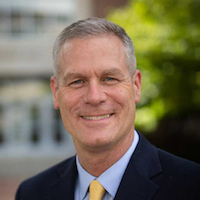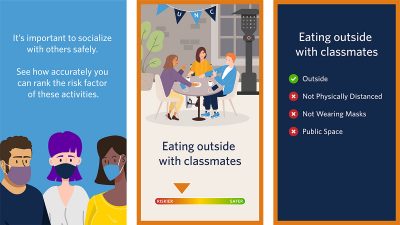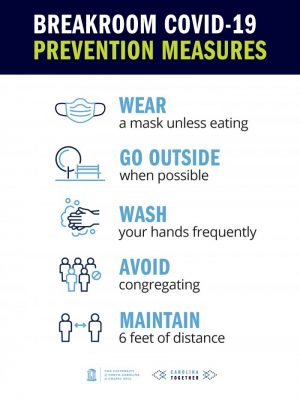March 24, 2021
University communicators face several challenges — and a daunting timeline — as they encourage students to keep safe during the pandemic.
“Smoking cessation and safer sex campaigns take years and decades to get results because to change behavior takes a long time,” said Beth Keith, associate vice chancellor for University Communications. “We are trying to normalize behaviors like wearing masks, not shaking hands and seeing your family for Christmas over Zoom. And our biggest challenge is to get that buy-in so quickly.”
Following the University’s pivot to remote instruction last year, Keith formed the Public Health Education Working Group, a core group of communicators focused on COVID-19 messaging for the University. The communicators sought information on coronavirus, infectious diseases, mental health and behavioral change, inviting Carolina’s top experts to speak to the group and guide the messaging.
Many of these speakers decided to stay.

Dr. Kurt Ribisl
“I teach a class on theories in health behavior and train our Master of Public Health students. But this is different,” said Kurt Ribisl, PhD, chair and Jo Anne Earp Distinguished Professor in the health behavior department of the UNC Gillings School of Global Public Health. “This is service-oriented. It’s applying what you know. This is about how can we get 24,000 students to buy into changing their behavior. And the stakes are really high.”
Targeting behavior
Over the summer, the Public Health Education Working Group expanded to include these experts as well as student, faculty and staff representatives who were able to give immediate feedback from target audiences. Now about 20 people join the Zoom meetings every other week to get updates, hear from the experts, give feedback and plan future campaigns. They advise leadership on messaging and develop and review content on the University’s pandemic-focused Carolina Together website.
When the group began meeting, an early goal was preparing the campus for students to return in the fall. That meant signs — lots of signs — posted in buildings: exits and entrances, one-way halls, occupancy limits, physical distancing, hand-washing and mask-wearing.
Then just days into the fall semester, clusters of COVID-19 infections popped up in residence halls. The University returned to remote instruction, and classroom buildings were empty. But some students with hardships (international students and those without internet service at home) remained on campus, and many others continued to live in the Chapel Hill area.

Dr. Audrey Pettifor
“It’s not like 10,000 students just left,” said Audrey Pettifor, PhD, professor of epidemiology. “Messaging for off-campus students had to continue. Safer behavior messaging was necessary.”
Early messaging focused on masks. Two Carolina-branded masks had been provided to every student, and messages on signs and social media reminded students to keep one in their backpack. One graphic showed the levels of risk of transmission between different combinations of people wearing masks and not wearing masks. An Instagram story showed the proper way to wear a mask. In a University video, students wearing masks shared their reasons with statements that began “I wear a face covering because …”
Safer socialization

Messaging on Instagram communicates the risk of activities during the COVID-19 pandemic.
Physical distancing was a tougher sell. Some big off-campus parties drew attention for potentially being super-spreader events in the fall, but contact tracing showed that clusters also developed from smaller gatherings of suitemates, study groups and close friends. Students seemed confused about how risky their behavior was.
As Pettifor knew from her studies about changing sexual behavior to prevent HIV transmission, “abstinence-only” messaging doesn’t work. “There are lots of parallels in how you communicate risks in general, even though this is a different disease,” she said. And just as effective HIV messaging emphasizes using condoms and limiting sexual partners, effective COVID-19 messaging offers alternatives to complete isolation.

A sign in a breakroom communicates COVID-19 prevention measures.
“Students are going to be congregating,” Ribisl said. “The messages have to be positive and say, ‘This is what you can do.’”
The group developed a “safer socialization” campaign that included a series of illustrations of how to make small gatherings safer by sitting farther apart, wearing masks and going outside. As the Super Bowl and the men’s basketball game against archrival Duke approached, the campaign focused on big game watching strategies with illustrations of listening to the game at a cookout or watching it on the big screen at an outdoor table.
The group also produced a sign specifically for employee break rooms after receiving feedback from staff members about unmasked co-workers socializing during breaks.
After much discussion, the group decided not to promote the idea of “bubbles” or “pods” for student socializing. “There are no clear-cut evidence-based guidelines for bubbles, and they also present some level of risk, which makes it harder to create communications around them,” Ribisl explained.
Stress continuum

Dr. Edwin B. Fisher
Another observation from Carolina’s health education experts was that the pandemic is affecting everyone’s mental health as much as it is their physical well-being. Keith said she had an aha! moment when clinical psychologist Edwin Fisher, PhD, professor of health behavior, talked to the group about how COVID-19 weighs on people’s minds even when they don’t realize it. Dealing with the pandemic influences feelings, sleep and efficiency. If people don’t recognize this, they may blame themselves for not being at their best.
They turned Fisher’s observation of COVID’s impacts into a video explaining the daily stress continuum, offering coping tips and resources. They included mental health in a series of Q&A videos with Carolina experts on topics such as safer socialization and risk assessment. They expanded referrals to mental health resources beyond the standard clinical ones to include peer support and self-care for those who need help coping but not necessarily an intervention.
As the University ramped up for the start of the spring semester and new COVID-19 testing requirements for students, the group turned its attention to testing. A series of videos explained testing procedures and requirements as well as how to use the HallPass testing app.
A new subgroup is working on the next major communications push to promote vaccinations using lessons learned about targeting specific audiences. Messages to employees will be more informational, while those for students will focus on their concern for elderly relatives.
The health education experts working with the Public Health Education Working Group don’t have the kind of data about the effectiveness of the communications that they would have for a research project. But they have been pleased with its efforts and consider it a success.
“This is how you get past siloing,” Fisher said of the group, a multidisciplinary gathering of faculty, staff and students from across campus. “This is a good model for us going forward. Here we have health experts working closely with communicators, developing messages, developing campaigns and changing culture.”
